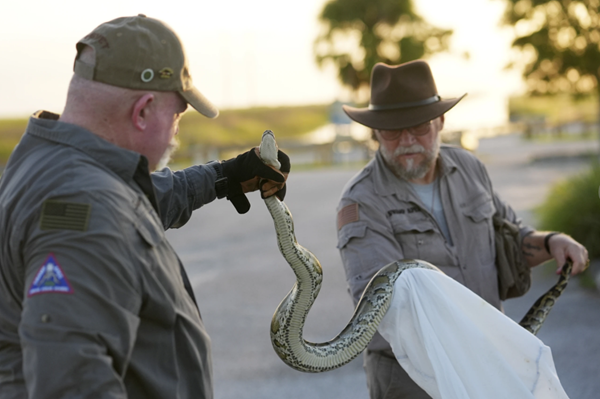It’s after midnight when Thomas Aycock’s pickup truck maneuvers through the sawgrass, down dirt roads deep in the Florida Everglades.
Aycock, a contractor with the Florida Fish and Wildlife Conservation Commission, has hunted Burmese pythons in the Everglades for 11 years. The retired U.S. Army veteran always participates in the Florida Python Challenge, hosted by the wildlife commission to incentivize people to track down invasive Burmese pythons that thrive in Florida’s preserved wetlands. This year’s 10-day challenge ended Sunday.
The timing is intentional: Pythons typically hatch from their small, leathery eggs each August before wriggling away into the swamp.
Aycok loves snakes. He’s also passionate about preserving the Everglades and understands the “greater ecological issue with these pythons,” a prolific apex predator threatening Florida’s native snakes and mammals.
The United States Geological Survey conservatively estimates tens of thousands have spread from South Florida. With each female laying clutches of 29-50 eggs on average, their impact has been devastating.
In one 2012 study, the USGS found populations of raccoons had declined by 99.3%, opossums by 98.9% and bobcats by 87.5% since the early 2000s. Controlling this voracious snake species, scientists say, is a critical goal.
More than 600 hunters participated in this year’s challenge, hoping to top last year’s total of 209 pythons killed. The grand prize winner, who humanely kills the most, receives $10,000.
The competition is designed to raise awareness and has succeeded on that score, attracting celebrities and inspiring reality television shows.
But the need for python control is so much bigger. Since 2017, Florida has been paying some 100 contractors to round them up year-round in a project shared by the wildlife agency and the South Florida Water Management District.
Through 2023, more than 18,000 pythons have been removed from the wild, with about 11,000 taken out by contractors like Aycock.
It’s a decent supplemental income -- $18 an hour if they walk into the swamp -- and contractors also get paid per snake: $50 for the first 4 feet plus $25 per subsequent foot.
Florida prohibits hunters from using firearms to kill pythons, and they aren’t venomous, so capturing them is very much a hands-on exercise.
But Burmese pythons, constrictors that have no natural predators and can swallow animals whole, aren’t always calm.
Aycock described the time when he caught a 17-foot python: He and his wife had to dance around the snake before he could wrangle the animal and control its head to keep the predator from lunging at them. Even then, a hunter needs a helper to keep the snake uncoiled until it calms down and can be double-bagged to prevent escape.
Once the snakes are caught, the hunters have 24 hours to deliver them to the wildlife agency. It is illegal for any person other than a licensed contractor to transport a live, invasive snake.
(AP Photo Wilfredo Lee)
Advertisement
Annual Python Challenge tries to control invasive population in Florida swamps
Advertisement
Latest State & National
State & National
13 hours ago
State & National
yesterday
State & National
yesterday
State & National
yesterday
State & National
yesterday
ADVERTISEMENT
Most Read >
ADVERTISEMENT
Latest State & National
State & National
13 hours ago
State & National
yesterday
State & National
yesterday
State & National
yesterday
State & National
yesterday
Advertisement
ADVERTISEMENT





